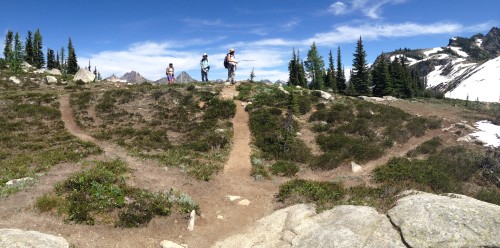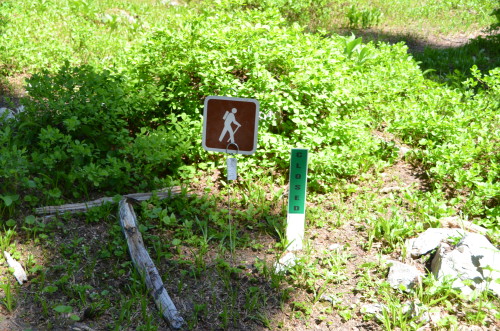Summertime Stewardship on Maple Pass — Join Us!

Washington is an amazing place. From the tide pools on the West Coast to the mountains in the heart of the state to the river gorges in the east, over one third of Washington is protected in one way or another. We have three National Parks, four National Recreation Areas and a mix of National Historic Sites, Parks, Reserves, Scenic Areas and Trails. We also have nine National Forests and a variety of capital-W Wilderness areas. One could say that the people of Washington treasure their land.
Of this protected land, 4.4% belongs to the realms of subalpine and alpine habitat. Normally, alpine habitats can be found at 10,000 feet or above; but in high latitudes like the North Cascades, alpine habitats start a little lower, between 5,000 and 7,000 feet. As visitors, we see alpine habitats as flower-filled, snow-ridden reaches that are the perfect spot for a day trip. But don’t let the beauty fool you: Alpine life is hard. The winters are long, summers are short and snowfall and wind levels are high. There is twice as much ultraviolet radiation and twenty-five percent more light than at sea level. Air at high elevations is thin and cold with temperatures ranging from -20°F in winter to 90°F in summer. With an average annual temperature of 37.5° F, alpine areas are ranked similarly to polar climates in that no month has a mean temperature higher than 50° F. In many alpine communities in the North Cascades, snow can be found on peaks year round, with some popular hikes not melting out until August. Come autumn, it will start snowing again before long, covering up the ground for another nine months. Weather can change very quickly and, since there are almost no places to hide, storms can be incredibly dangerous.
 Imagine being a plant in the alpine. What adaptations would you need to the harsh conditions? Pictured here is a favorite species of the subalpine: Western pasqueflower (Anemone occidentalis), before it develops into its frizzled-haired fruit. Photo by Katherine Renz.
Imagine being a plant in the alpine. What adaptations would you need to the harsh conditions? Pictured here is a favorite species of the subalpine: Western pasqueflower (Anemone occidentalis), before it develops into its frizzled-haired fruit. Photo by Katherine Renz.
Now, imagine being a plant in the alpine. Rarely, if ever, does it rain, so you get your moisture from the long lasting snow packs. If the soil has not already blown away, it is nutrient-poor and makes it difficult to grow roots. The sun is hot and will burn new, tender leaves if you don’t figure out a way to adapt. The snow lasts quite a while, so you could only have two months to produce flowers and become pollinated before you are covered up by the white blanket again. Long lasting snow can be heavy and push you down; yet if you grow too tall, avalanches can knock you over. If you are lucky enough to survive all of that, you still have to avoid being eaten by an alpine herbivore.
Luckily, for alpine plants, they have a series of adaptions to help them survive such difficult life. Waxy, hair covered leaves help retain moisture. Long, strong taproots burrow deep into the rocky soil in search of hard to find nutrients. Anthocyanin, a reddish pigment acts to speed up photosynthesis and as a sunblock from the harsh sun. Instead of rushing through the reproductive season, plants extend the flower production and blooming process out over a few years to best maximize their short time uncovered by snow. Taproots and a short cushion-like shape help keep plants anchored to the ground in high winds and avalanches. It would seem as if alpine plants have it figured out. However, they still must contend with the challenges we humans rarely fail to offer.
 One of the many beautiful views from the Maple Loop trail with bountiful white and pink heather (Cassiope mertensiana and Phyllodoce empetriformis). Photo by author.
One of the many beautiful views from the Maple Loop trail with bountiful white and pink heather (Cassiope mertensiana and Phyllodoce empetriformis). Photo by author.
We come in with our heavy boots, sharp trekking poles and large numbers. We mean no harm, but to an alpine plant, too much tramping is the difference between life and death. I’ve been told that 12 steps on an alpine plant will kill it. Lush meadows and heather patches that once guarded the entrances to the alpine world now stand bare, opening up the precious soil to the elements. Social trails, campsites, lunch spots and viewpoints are all leading to the further degradation of alpine habitats.
So, this summer, my Leadership Track (a position I hold as part of my Graduate studies) is focused on working towards restoring alpine and subalpine habitats. We will be closing some social trails, rerouting the trail at some points, posting educational signs, and collecting seed and plant clippings. With those seeds and clippings we hope to grow them at the Marblemount Greenhouse to be planted at a later date. We collect them on site in order to preserve the genetic identity of the plants at Maple Pass, as well as to best support these plants in their bid to grow at high elevations.
 Lake Ann, as seen from the Maple Loop trail in between Heather and Maple Pass. Photo by author.
Lake Ann, as seen from the Maple Loop trail in between Heather and Maple Pass. Photo by author.
The work I am participating in will take place along the Maple Pass Loop. Thanks to its easy access and astounding beauty, it is one of the most heavily traveled trails along Highway 20. I’m sure many of you have hiked this trail, but if you haven’t, move it up higher on your ‘To Hike’ list this summer. Splitting off from the Rainy Lake trailhead, the trail ascends quickly through fir, spruce and hemlock stands. Huckleberry bushes fill in the understory and soon enough the wildflowers start to show their pretty blooms. At 1.3 miles you hit the trail for Lake Ann. Continuing on the loop, the subalpine world of heathers and low shrubs quickly come into view, as do the peaks and a view of Lake Ann. Depending on the time of year, snowfields will come into view at around 2.5 miles, soon after the split to Heather Pass. With the snowfields come more wildflowers; glacier lilies, paintbrush, penstemon and lupine among them. As you walk the rim and look down into Lake Ann, Maple Pass shows itself in the distance. At 3.5 miles and 6,600’ of elevation, you are at the pass itself. This is where I will be spending a good portion of my time and energy for the rest of the summer.
I am working in tandem with the Methow Valley Ranger District of the Okanagan-Wenatchee National Forest and the North Cascades National Park on a project called the Maple Pass Restoration Plan. This plan, funded in part by the National Forest Foundation, falls under the larger “Treasured Landscapes, Unforgettable Experiences” Project. The goal of “Treasured Landscapes” is to ‘revitalize our forests and strengthen our natural connection’ through stewardship, restoration, building better community bonds to the natural world and education.
 Because even just our well-intentioned footsteps as we commune with nature can leave a big, destructive trace. Photo by author.
Because even just our well-intentioned footsteps as we commune with nature can leave a big, destructive trace. Photo by author.
The Maple Pass Plan is not the only National Forest Funded restoration project in Washington. A group of projects, collectively called the ‘Majestic Methow’ are working towards goals of ecological restoration, aquatic habitat restoration, wildlife habitat restoration and better connections between science and action within our greater community. Many of these areas are considered backcountry and some even lie in Wilderness areas. A few however, like Maple Pass, are easily accessible, with trailheads located right off Highway 20.
This summer marks the first effort of this multi-year project. My job is to help coordinate our different visits to the site, advertise the work to the general public and bring in volunteers to assist with our work. We have over an acre of trails to replant, 2,000 feet of social trails to close and almost a mile of trail to reconstruct. My work in this project will end before the job is done, however. The restoration process, notably plant propagation, will continue for a few years. After the initial trail closings and plantings, the site will be monitored for a few years to assist with plant regrowth.
Hopefully, this effort will result in a vastly different looking Maple Pass in five years, and a healthier ecosystem overall. For now though, I must think smaller, and focus on re-potting all of the tiny huckleberry and heather that I love so much.
If you or someone you know is interested in volunteering along side of us this summer, please contact me at Samantha_hale@ncascades.org.
 Who knows? You may get lucky enough to see a marmot like this one as you replant baby subalpine heathers. Photo by Katherine Renz.
Who knows? You may get lucky enough to see a marmot like this one as you replant baby subalpine heathers. Photo by Katherine Renz.
Leading photo: Three separate trails tri-sect the fragile heather community at the viewpoint to Maple Pass Loop. Braided trails such as these show just how numerous and intricate social trails can be. Over time, these trails lead to large bare dirt patches and soil erosion. Let’s see if we can work this summer to make it a single track.
Samantha Hale is a graduate student in North Cascades Institute and Western Washington University’s M.Ed. program. Once a self-professed ‘ocean only’ lover she is starting to see the merits of frolicking, Julie Andrews style, amongst alpine plants. You can find her, DSLR in one hand, hand-lens in another, walking the high ridges.


I recall Aug. 17th and 18th as the dates mentioned for a restoration planning session. I have an appointment on the 18th I’d have to change in order to attend. Please send details. I emailed Kathy Corrigan and Mike Liu about our sign restoration Sunday. -Eric